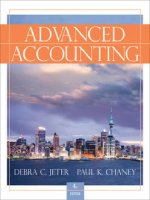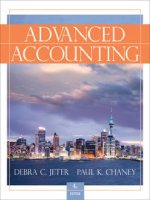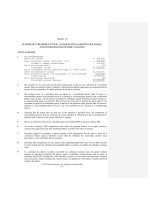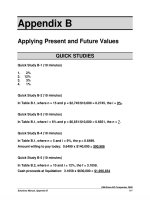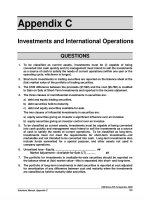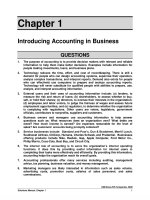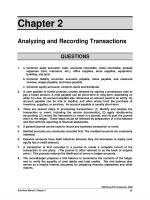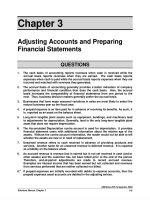Solution manual financial accounting 4e by wild chapter10
Bạn đang xem bản rút gọn của tài liệu. Xem và tải ngay bản đầy đủ của tài liệu tại đây (1.39 MB, 65 trang )
To download more slides, ebook, solutions and test bank, visit
Chapter 10
Reporting and Analyzing
Long-Term Liabilities
QUESTIONS
1.
A bond is a liability of the issuing company. A share of stock represents an ownership
interest in the company.
2.
Notes payable generally involve borrowing from a single creditor, whereas bonds
payable are usually sold to many different lenders (bondholders).
3.
Bonds can allow a company’s owners to increase their return on equity without investing
additional amounts. This result occurs as long as the rate of return on the assets
acquired from the borrowed cash is greater than the interest rate paid on the bonds.
Bonds also help the current owners remain in control of the company. There is also a tax
advantage with bonds when issued by corporations.
4.
A trustee for bondholders has the responsibility of monitoring the issuer’s actions,
financial performance, and financial condition to ensure that the obligations in the bond
indenture are met.
5.
A bond indenture is a legal contract between the issuing company and the bondholders
that identifies the obligations and rights of both parties. It specifies such items as the
par value of the bonds, the contract interest rate, the due dates for interest payments,
and the maturity date(s) of the bonds. It also may name a trustee, describe the bond
issue in detail, and provide for a sinking fund.
6.
The contract rate (also known as the coupon rate, stated rate, or nominal rate) is the rate
that is identified in the bond indenture. It is applied to the par value to determine the size
of the cash interest payments. The market rate is the consensus rate that a company is
willing to pay and that investors are willing to accept for a specific bond.
7.
In general, the supply of and demand for bonds affect market rates. The market rate for
a particular bond issue is also affected by risks unique to the issuer (e.g., financial
performance and condition) and the length of time until the bonds mature.
8.B The effective interest method creates a constant rate of interest over a bond’s life
because the market rate at the time of issuance is multiplied by the beginning balance
for each period. The straight-line method produces either an increasing or decreasing
rate because it allocates the same amount of expense to each period, even if the liability
balance is growing (a discount) or decreasing (a premium).
9.C When issuing bonds between interest dates, a company collects accrued interest from
the purchasers to avoid keeping detailed records of bond purchasers and the dates
when bonds are purchased. If the company did not collect accrued interest, individual
checks would be needed to pay the correct amount of interest to each purchaser. By
©McGraw-Hill Companies, 2008
Solutions Manual, Chapter 10
515
To download more slides, ebook, solutions and test bank, visit
collecting in advance, the issuer merely distributes the same amount per check to all
bondholders, regardless of when they purchased the bonds.
10. The price of bonds can be computed by finding the present value of both the par value at
maturity and the periodic cash interest payments discounted at the market rate of
interest.
11. The issue price of a $2,000 bond sold at 98 ¼ is 98.25% of $2,000, or $1,965. The issue
price of a $6,000 bond priced at 101 ½ is 101.5% of $6,000, or $6,090.
12. The debt-to-equity ratio is calculated by dividing total liabilities by total equity. The
higher a company’s debt-to-equity ratio, the higher proportion of a company’s assets
that are provided by creditors. If a company has a high debt-to-equity ratio, the company
may be at risk during poor economic times, because it must still pay off creditors even
though it may not be earning as much as it did in the past.
13. An entrepreneur (owner) must repay the bondholders the principal (par value) according
to the term of the bonds. He or she must also pay interest on the bonds per the amount
and frequency cited in the bond indenture, and must adhere to any stipulations
(covenants) specified in the bond contract.
14. Best Buy shows long-term both ―Long-term Liabilities‖ and ―Long-Term Debt‖ on its
balance sheet. To determine whether the long term debt is comprised of bonds or other
obligations we must read footnote 4 disclosing details of the Long-Term Debt of the
company. The footnote reports that its long-term debt is comprised of Convertible
debentures (bonds), Lease Obligations, and Mortgages.
15. Per Circuit City’s February 28, 2005, statement of cash flows (financing section), the
company repaid $28,008,000 for the fiscal year ended February 28, 2005.
16. The financing section of the statement of cash flows of Apple indicates that for the year
ended September 25, 2004, the company issued common stock totaling $427,000,000.
For that same period, the company repaid debt in the amount of $300,000,000.
17.D If a lease qualifies to be recorded as a capital lease, an asset account for the leased
asset will be debited with an amount equal to the present value of the future lease
payments. The corresponding credit will be to a lease liability account.
18.D An operating lease is a short-term or cancelable lease in which the lessor retains the
risks and rewards of ownership. The lessee expenses operating lease payments when
incurred and the lessee does not report the leased item(s) as an asset nor as a liability.
A capital lease is a long-term or noncancelable lease in which the lessor transfers
substantially all the risks and rewards of ownership to the lessee. The lessee records
the leased item as its own asset along with a lease liability at the start of the lease term—
the amount recorded equals the present value of all lease payments.
19.D Pension plans can be designed as defined benefit plans or defined contribution plans. In
a defined benefit plan the employer estimates the contribution necessary to pay a predefined benefit amount to its retirees. For example, an employee’s monthly pension
benefit may be set at $1,000 per month. The employer must contribute the amount
necessary to the pension plan to fund the $1,000 a month to the employee when the
employee retires.
Alternatively, with a defined contribution plan, the pension
contribution is defined and the employer or employee contributes the amount specified
in the pension agreement. For example, a defined contribution plan might specify that
the employer will contribute 2% of an employee’s annual salary to the pension plan every
year.
©McGraw-Hill Companies, 2008
516
Financial Accounting, 4th Edition
To download more slides, ebook, solutions and test bank, visit
QUICK STUDIES
Quick Study 10-1 (10 minutes)
1.
Bond’s cash proceeds: $250,000 x 0.875 = $218,750
2.
Twenty semiannual interest payments of $10,000* ....
Plus bond discount ($250,000 - $218,750) ...................
Total bond interest expense .........................................
*$250,000 x 0.08 x ½ = $10,000
3.
Bond interest expense on first payment date:
$231,250 / 20 semiannual periods = $11,563
$200,000
31,250
$231,250
Quick Study 10-2B (10 minutes)
1.
Bond’s cash proceeds: $240,000 x 1.1725 = $281,400
2.
Thirty semiannual interest payments of $12,000* .......
Less premium ($281,400 - $240,000) ............................
Total bond interest expense .........................................
*$240,000 x 0.10 x ½ = $12,000
3.
Bond interest expense on first payment date:
$281,400 x 4% = $11,256
$360,000
(41,400)
$318,600
Quick Study 10-3 (10 minutes)
2008
Jan. 1
Cash ................................................................................
218,750
Discount on Bonds Payable .........................................
31,250
Bonds Payable .........................................................
250,000
To record issuing bonds at a discount.
Jan. 1
Cash ................................................................................
281,400
Bonds Payable .........................................................
240,000
Premium on Bonds Payable ...................................
41,400
To record issuing bonds at a premium.
©McGraw-Hill Companies, 2008
Solutions Manual, Chapter 10
517
To download more slides, ebook, solutions and test bank, visit
Quick Study 10-4 (10 minutes)
a. Using facts in QS 10-1, the bond’s cash proceeds for the bond selling at
a discount are computed as follows
Cash Flow
Table Value
$250,000 par (maturity) value ................ 0.3769
$10,000 interest payment ....................... 12.4622
Price of Bond .......................................
*
Present Value
$ 94,225
124,622
$218,847*
Agrees with $218,750 as given in QS 10-1, except for rounding difference.
(Instructor note: The price in QS 10-1 is rounded to 87.5 from 87.5388, yielding the $97 difference.)
b. Using facts in QS 10-2, the bond’s cash proceeds for the bond selling at
a premium are computed as
Cash Flow
Table Value
$240,000 par (maturity) value ................
0.3083
$ 12,000 interest payment ..................... 17.2920
Price of Bond .......................................
Present Value
$ 73,992
207,504
$281,496*
*
Agrees with $281,400 as given in QS 10-2, except for rounding difference.
(Instructor note: The price in QS 10-2 is rounded to 117.5 from 117.29, yielding the $96 difference.)
Quick Study 10-5 (10 minutes)
2008
July 1
Bonds Payable ...............................................................
400,000
Premium on Bonds Payable .........................................
16,000
Gain on Retirement of Bonds* ................................
Cash ..........................................................................
8,000
408,000
To record retirement of bonds before maturity.
*$8,000 = $416,000 - $408,000
Quick Study 10-6 (10 minutes)
2008
Jan. 1
Bonds Payable .................................................................
2,000,000
Common Stock* .........................................................
Paid-In Capital in Excess of Par Value .......................
1,000,000
1,000,000
To record retirement of bonds by stock
conversion. *1,000,000 shares x $1.00
©McGraw-Hill Companies, 2008
518
Financial Accounting, 4th Edition
To download more slides, ebook, solutions and test bank, visit
Quick Study 10-7 (10 minutes)
Initial cash proceeds from note
Amount of annual payment = Table B.3 present value for 5 payments
a.
4%: Payment = $340,000 / 4.4518 = $76,374
b.
8%: Payment = $340,000 / 3.9927 = $85,155
c.
12%: Payment = $340,000 / 3.6048 = $94,319
Quick Study 10-8 (10 minutes)
1.
2.
3.
4.
A
C
H
F
Registered bond
Serial bond
Secured bond
Bearer bond
5.
6.
7.
8.
E
D
G
B
Convertible bond
Bond Indenture
Sinking fund bond
Debenture
Quick Study 10-9 (10 minutes)
Ratio of debt to equity
Atlanta Company
Spokane Company
Total liabilities ..........................
$429,000
$ 548,000
Total equity ...............................
$572,000
$1,827,000
Debt-to-equity ratio ..................
0.75
0.30
Analysis and interpretation: Atlanta Company’s debt-to-equity ratio of 0.75
implies a riskier financing structure than Spokane Company’s 0.30 debt-toequity ratio.
Quick Study 10-10C (10 minutes)
2008
Mar. 1
Cash ................................................................................
405,333
Interest payable* ......................................................
5,333
Bonds payable .........................................................
400,000
Sold $400,000 of bonds with two months’
accrued interest. *($400,000 x .08 x 2/12)
©McGraw-Hill Companies, 2008
Solutions Manual, Chapter 10
519
To download more slides, ebook, solutions and test bank, visit
Quick Study 10-11C (10 minutes)
Rental Expense .............................................................. 250
Cash (or Payable).....................................................
250
To record rental expense for car lease.
Quick Study 10-12C (10 minutes)
Leased Asset—Office Equipment ................................
15,499
Lease Liability ..........................................................
15,499
To record capital lease of office equipment.
©McGraw-Hill Companies, 2008
520
Financial Accounting, 4th Edition
To download more slides, ebook, solutions and test bank, visit
EXERCISES
Exercise 10-1 (15 minutes)
1.
Semiannual cash interest payment = $3,400,000 x 9% x 1/2 = $153,000
2.
Journal entries
2008
(a)
Jan. 1 Cash ................................................................................
3,400,000
Bonds Payable .........................................................
3,400,000
Sold bonds at par.
(b)
June 30
Bond Interest Expense ..................................................
153,000
Cash ..........................................................................
153,000
Paid semiannual interest on bonds.
(c)
Dec. 31
Bond Interest Expense ..................................................
153,000
Cash ..........................................................................
153,000
Paid semiannual interest on bonds.
3.
2008
(a)
Jan.
1
Cash*...............................................................................
3,332,000
Discount on Bonds Payable .........................................
68,000
Bonds Payable .........................................................
3,400,000
Sold bonds at 98. *($3,400,000 x 0.98)
(b)
Jan.
1
Cash*...............................................................................
3,468,000
Premium on Bonds Payable ...................................
Bonds Payable .........................................................
68,000
3,400,000
Sold bonds at 102. *($3,400,000 x 1.02)
©McGraw-Hill Companies, 2008
Solutions Manual, Chapter 10
521
To download more slides, ebook, solutions and test bank, visit
Exercise 10-2 (30 minutes)
1. Discount = Par value - Issue price = $180,000 - $170,862 = $9,138
2. Total bond interest expense over the life of the bonds
Amount repaid
Six payments of $7,200* .................
Par value at maturity ......................
Total repaid......................................
Less amount borrowed .....................
Total bond interest expense .............
$ 43,200
180,000
223,200
(170,862)
$ 52,338
*180,000 x 0.08 x ½ = $7,200
or:
Six payments of $7,200 ............................. $ 43,200
Plus discount .............................................
9,138
Total bond interest expense ..................... $ 52,338
3. Straight-line amortization table ($9,138/6 = $1,523)
Semiannual
Period-End
Unamortized
Discount
Carrying
Value
(0)
1/01/2008 .........................$9,138
$170,862
(1)
6/30/2008 ......................... 7,615
172,385
(2) 12/31/2008 ......................... 6,092
173,908
(3)
6/30/2009 ......................... 4,569
175,431
(4) 12/31/2009 ......................... 3,046
176,954
(5)
178,477
6/30/2010 ......................... 1,523
(6) 12/31/2010 .........................
0
180,000
©McGraw-Hill Companies, 2008
522
Financial Accounting, 4th Edition
To download more slides, ebook, solutions and test bank, visit
Exercise 10-3B (30 minutes)
1. Discount = Par value - Issue price = $500,000 - $463,140 = $36,860
2. Total bond interest expense over the life of the bonds
Amount repaid
Six payments of $22,500* ....................... $135,000
Par value at maturity .............................. 500,000
Total repaid.............................................. 635,000
Less amount borrowed ............................. (463,140)
Total bond interest expense ..................... $171,860
*$500,000 x 0.09 x ½ = $22,500
or
Six payments of $22,500 ........................... $135,000
Plus discount .............................................
36,860
Total bond interest expense ..................... $171,860
3. Effective interest amortization table
Semiannual
Interest
Period-End
(A)
Cash Interest
Paid
(B)
Bond Interest
Expense
[4.5% x $500,000]
[6% x Prior (E)]
(C)
(D)
Discount
Unamortized
Amortization
Discount
[(B) - (A)]
1/01/2008
(E)
Carrying
Value
[Prior (D) - (C)] [$500,000 - (D)]
$36,860
$463,140
6/30/2008
$ 22,500
$ 27,788
$ 5,288
31,572
468,428
12/31/2008
22,500
28,106
5,606
25,966
474,034
6/30/2009
22,500
28,442
5,942
20,024
479,976
12/31/2009
22,500
28,799
6,299
13,725
486,275
6/30/2010
22,500
29,176
6,676
7,049
492,951
12/31/2010
22,500
29,549 *
7,049
0
500,000
$135,000
$171,860
$36,860
*Adjusted for rounding.
©McGraw-Hill Companies, 2008
Solutions Manual, Chapter 10
523
To download more slides, ebook, solutions and test bank, visit
Exercise 10-4 (30 minutes)
1. Premium = Issue price - Par value = $409,850 - $400,000 = $9,850
2. Total bond interest expense over the life of the bonds
Amount repaid
Six payments of $26,000* ...............
Par value at maturity ......................
Total repaid......................................
Less amount borrowed .....................
Total bond interest expense .............
$156,000
400,000
556,000
(409,850)
$146,150
*$400,000 x 0.13 x ½ = $26,000
or
Six payments of $26,000 ...................
Less premium.....................................
Total bond interest expense .............
$156,000
(9,850)
$146,150
3. Straight-line amortization table ($9,850/6 = $1,642)
Semiannual
Interest Period-End
Unamortized
Premium
Carrying
Value
1/01/2008
$9,850
$409,850
6/30/2008
8,208
408,208
12/31/2008
6,566
406,566
6/30/2009
4,924
404,924
12/31/2009
3,282
403,282
6/30/2010
1,640*
401,640
12/31/2010
0
400,000
*Adjusted for rounding.
©McGraw-Hill Companies, 2008
524
Financial Accounting, 4th Edition
To download more slides, ebook, solutions and test bank, visit
Exercise 10-5B (30 minutes)
1. Premium = Issue price - Par value = $409,850 - $400,000 = $9,850
2. Total bond interest expense over the life of the bonds
Amount repaid
Six payments of $26,000* ....................... $ 156,000
Par value at maturity .............................. 400,000
Total repaid.............................................. 556,000
Less amount borrowed ............................. (409,850)
Total bond interest expense ..................... $ 146,150
*$400,000 x 0.13 x ½ = $26,000
or
Six payments of $26,000 ........................... $ 156,000
Less premium.............................................
(9,850)
Total bond interest expense ..................... $ 146,150
3. Effective interest amortization table
Semiannual
Interest
Period-End
(A)
Cash Interest
Paid
(B)
Bond Interest
Expense
[6.5% x $400,000]
[6% x Prior (E)]
(C)
(D)
Premium
Unamortized
Amortization
Premium
[(A) - (B)]
1/01/2008
(E)
Carrying
Value
[Prior (D) - (C)]
[400,000 + (D)]
$9,850
$409,850
6/30/2008
$ 26,000
$ 24,591
$1,409
8,441
408,441
12/31/2008
26,000
24,506
1,494
6,947
406,947
6/30/2009
26,000
24,417
1,583
5,364
405,364
12/31/2009
26,000
24,322
1,678
3,686
403,686
6/30/2010
26,000
24,221
1,779
1,907
401,907
12/31/2010
26,000
24,093*
1,907
0
400,000
$156,000
$146,150
$9,850
*Adjusted for rounding.
©McGraw-Hill Companies, 2008
Solutions Manual, Chapter 10
525
To download more slides, ebook, solutions and test bank, visit
Exercise 10-6 (25 minutes)
1. Semiannual cash interest payment = $800,000 x 6% x ½ year = $24,000
2. Number of payments = 10 years x 2 per year = 20 semiannual payments
3. The 6% contract rate is less than the 8% market rate; therefore, the
bonds are issued at a discount.
4. Estimation of the market price at the issue date
Cash Flow
Table
Par (maturity) value ........B.1
Interest (annuity) .............B.3
Price of bonds .................
Table Value*
0.4564
13.5903
Amount
$800,000
24,000
Present Value
$365,120
326,167
$691,287
* Table values are based on a discount rate of 4% (half the annual market rate) and
20 periods (semiannual payments).
5.
Cash ................................................................................
691,287
Discount on Bonds Payable..........................................
108,713
Bonds Payable .........................................................
800,000
Sold bonds at a discount on the stated issue date.
Exercise 10-7 (25 minutes)
1. Semiannual cash interest payment = $150,000 x 10% x ½ year = $7,500
2. Number of payments = 5 years x 2 per year = 10 semiannual payments
3. The 10% contract rate is greater than the 8% market rate; therefore, the
bonds are issued at a premium.
4. Estimation of the market price at the issue date
Cash Flow
Table Table Value*
Par (maturity) value ........ B.1
0.6756
Interest (annuity) ............. B.3
8.1109
Price of bonds .................
Amount
$150,000
7,500
Present Value
$101,340
60,832
$162,172
* Table values are based on a discount rate of 4% (half the annual market rate) and
10 periods (semiannual payments).
5.
Cash ................................................................................
162,172
Premium on Bonds Payable....................................
12,172
Bonds Payable .........................................................
150,000
Sold bonds at a premium on the stated issue date.
©McGraw-Hill Companies, 2008
526
Financial Accounting, 4th Edition
To download more slides, ebook, solutions and test bank, visit
Exercise 10-8 (20 minutes)
1. Cash proceeds from sale of bonds at issuance
$700,000 x 97.75% = $684,250
2. Discount at issuance
Par value ................................................
Cash issue price (from part 1) .............
Discount at issuance ............................
$700,000
(684,250)
$ 15,750
3. Total amortization for first 6 years
The first six years (from 1/1/07 to 12/31/12) equals 40% of the bonds’ 15year life. Therefore, the total amortization equals 40% of the total
discount (since straight-line amortization is being used), which is
$15,750 x 40%, or $6,300.
4. Carrying value of the bonds at 12/31/2012
Discount at issuance (from part 2) ......
Less amortization (from part 3) ...........
Remaining discount .............................
$ 15,750
(6,300)
$ 9,450
Entire Group
Par value .................................................
$700,000
Remaining discount ..............................
(9,450)
Carrying value ........................................
$690,550
Retired 20%
$140,000
(1,890)
$138,110
5. Cash purchase price
($700,000 x 20%) x 104.5% = $146,300
6. Loss on retirement
Cash paid (from part 5) ......................
Carrying value (from part 4) ...............
Loss on retirement ..............................
$146,300
(138,110)
$ 8,190
7. Journal entry at retirement for 20% of bonds
2013
Jan. 1 Bonds Payable ................................................................
140,000
Loss on Retirement of Bonds Payable.........................
8,190
Discount on Bonds Payable ....................................
Cash ...........................................................................
1,890
146,300
To record the retirement of bonds.
©McGraw-Hill Companies, 2008
Solutions Manual, Chapter 10
527
To download more slides, ebook, solutions and test bank, visit
Exercise 10-9C (20 minutes)
1. Semiannual cash interest payment = $3,400,000 x 9% x ½ year = $153,000
Amount accrued for four months = $153,000 x 4/6 = $102,000
2. Journal entries
2008
May
1
Cash ................................................................................
3,502,000
Interest Payable .......................................................
Bonds Payable .........................................................
102,000
3,400,000
Sold bonds with 4 months’ accrued interest.
June 30
Interest Payable .............................................................
102,000
Bond Interest Expense ..................................................
51,000
Cash ..........................................................................
153,000
Paid semiannual interest on the bonds.
Dec. 31
Bond Interest Expense ..................................................
153,000
Cash ..........................................................................
153,000
Paid semiannual interest on the bonds.
©McGraw-Hill Companies, 2008
528
Financial Accounting, 4th Edition
To download more slides, ebook, solutions and test bank, visit
Exercise 10-10 (40 minutes)
1.
Straight-line amortization table ($4,052/8 = $506.5)
Semiannual
Period-End
Unamortized
Discount †
Carrying
Value
6/01/2007 .....................
$4,052
$95,948
11/30/2007 .....................
3,546
96,454
5/31/2008 .....................
3,040
96,960
11/30/2008 .....................
2,534
97,466
5/31/2009 .....................
2,028
97,972
11/30/2009 .....................
1,522
98,478
5/31/2010 .....................
1,016
98,984
11/30/2010 .....................
5/31/2011 .....................
*
†
506*
0
99,494
100,000
Adjusted for rounding difference.
Supporting computations
Eight payments of $3,500** ....................
Par value at maturity...............................
Total repaid .............................................
Less amount borrowed ..........................
Total bond interest expense ..................
**$100,000 x 0.07 x ½ = $3,500
or
Eight payments of $3,500 .......................
Plus discount ..........................................
Total bond interest expense ..................
$ 28,000
100,000
128,000
(95,948)
$ 32,052
$ 28,000
4,052
$ 32,052
Semiannual straight-line interest expense = $32,052 / 8 = $4,006 (rounded)
Semiannual bond discount amortization = $4,052 / 8 = $506 (rounded)
©McGraw-Hill Companies, 2008
Solutions Manual, Chapter 10
529
To download more slides, ebook, solutions and test bank, visit
Exercise 10-10 (Concluded)
2.
2007
Nov. 30
Bond Interest Expense ..................................................4,006
Discount on Bonds Payable ...................................
Cash ..........................................................................
506
3,500
To record 6 months’ interest and discount amortization.
Dec. 31
Bond Interest Expense .................................................. 668
Discount on Bonds Payable ...................................
Interest Payable .......................................................
84
584
To record one month's accrued interest
($4,006 x 1/6) and amortization ($501 x 1/6).
2008
May 31
Interest Payable ............................................................. 584
Bond Interest Expense ..................................................3,338
Discount on Bonds Payable ...................................
Cash ..........................................................................
422
3,500
To record five months’ interest ($4,006 - $668)
and amortization ($506 - $84) and eliminate
the accrued interest liability.
©McGraw-Hill Companies, 2008
530
Financial Accounting, 4th Edition
To download more slides, ebook, solutions and test bank, visit
Exercise 10-11 (20 minutes)
1. Amount of each payment = Initial note balance / Table B.3 value
= $100,000 / 3.3872 = $29,523
2. Amortization table for the loan
(A)
Period
Ending
Date
Beginning
Balance
(B)
Debit
Interest
Expense
[Prior (E)]
[7% x (A)]
+
Payments
(C)
Debit
Notes
Payable
=
[(D) - (B)]
(D)
Credit
(E)
Cash
Ending
Balance
[computed]
[(A) - (C)]
2008 .......
$100,000
$ 7,000
$ 22,523
$ 29,523
$77,477
2009 .......
77,477
5,423
24,100
29,523
53,377
2010 .......
53,377
3,736
25,787
29,523
27,590
2011 .......
27,590
1,933*
27,590
29,523
0
$100,000
$118,092
$18,092
*Adjusted for rounding.
©McGraw-Hill Companies, 2008
Solutions Manual, Chapter 10
531
To download more slides, ebook, solutions and test bank, visit
Exercise 10-12 (20 minutes)
2008
Jan. 1
Cash ................................................................................
100,000
Notes Payable ..........................................................
100,000
Borrowed $100,000 by signing a 7%
installment note.
2008
Dec. 31
Interest Expense ............................................................
7,000
Notes Payable ................................................................
22,523
Cash ..........................................................................
29,523
To record first installment payment.
2009
Dec. 31
Interest Expense ............................................................
5,423
Notes Payable ................................................................
24,100
Cash ..........................................................................
29,523
To record second installment payment.
2010
Dec. 31
Interest Expense ............................................................
3,736
Notes Payable ................................................................
25,787
Cash ..........................................................................
29,523
To record third installment payment.
2011
Dec. 31
Interest Expense ............................................................
1,933
Notes Payable ................................................................
27,590
Cash ..........................................................................
29,523
To record fourth installment payment.
©McGraw-Hill Companies, 2008
532
Financial Accounting, 4th Edition
To download more slides, ebook, solutions and test bank, visit
Exercise 10-13 (15 minutes)
1a. Current debt-to-equity ratio = $220,000 / $390,000* = 0.564
*Total equity = $610,000 - $220,000 = $390,000
1b. Potential debt-to-equity ratio = $720,000* / $390,000 = 1.846
*Total liabilities = $220,000 + $500,000 = $720,000
2.
Montclair’s risk will increase because it will have more debt. That debt
(plus interest) must be repaid even if the project does not work out as
planned and provide a sufficient profit. However, if the project does
provide adequate returns, Montclair may be better off in the long run
by borrowing the funds.
Exercise 10-14D (10 minutes)
1. Operating
2. Capital
3. Capital
Exercise 10-15D (20 minutes)
1.
Leased Asset—Office Equipment ................................
41,000
Lease Liability ..........................................................
41,000
To record capital lease of office equipment.
2.
Depreciation Expense—Office Equipment ..................8,200
Accum. Depreciation—Office Equipment..............
8,200
To record depreciation ($41,000 / 5 years).
Exercise 10-16D (15 minutes)
[Note: 12% / 12 months = 1% per month as the relevant interest rate.]
Option 1: $1,750 per month for 25 months = $1,750 x 22.0232 = $38,541
Option 2: $1,500 per month for 25 months + $5,000 =
($1,500 x 22.0232) + $5,000 = $38,035
Option 3:
= $38,500
Analysis: Option 2 has the lowest present value at $38,035 and, thus, is the
best lease deal.
©McGraw-Hill Companies, 2008
Solutions Manual, Chapter 10
533
To download more slides, ebook, solutions and test bank, visit
PROBLEM SET A
Problem 10-1A (50 minutes)
Part 1
a.
Cash Flow
Table
Par value ..................... B.1
Interest (annuity) ........ B.3
Price of bonds ............
Table Value*
0.4564
13.5903
Amount
$40,000
2,000*
Bond premium ............
Present Value
$18,256
27,181
$45,437
$ 4,537
*$40,000 x 0.10 x ½ = $2,000
* Table values are based on a discount rate of 4% (half the annual market rate)
and 20 periods (semiannual payments).
b.
2008
Jan. 1
Cash ................................................................................
45,437
Premium on Bonds Payable ...................................
Bonds Payable .........................................................
4,537
40,000
Sold bonds on stated issue date.
Part 2
a.
Cash Flow
Table
Par value ..................... B.1
Interest (annuity) ........ B.3
Price of bonds ............
Table Value*
0.3769
12.4622
Amount
$40,000
2,000
Present Value
$15,076
24,924
$40,000
* Table values are based on a discount rate of 5% (half the annual market rate) and
20 periods (semiannual payments). (Note: When the contract rate and market rate
are the same, the bonds sell at par and there is no discount or premium.)
b.
2008
Jan. 1
Cash ................................................................................
4,000
Bonds Payable .........................................................
40,000
Sold bonds on stated issue date.
©McGraw-Hill Companies, 2008
534
Financial Accounting, 4th Edition
To download more slides, ebook, solutions and test bank, visit
Problem 10-1A (Concluded)
Part 3
a.
Cash Flow
Table
Par value .................... B.1
Interest (annuity) ....... B.3
Price of bonds ...........
Table Value*
0.3118
11.4699
Bond discount ...........
Amount
$40,000
2,000
Present Value
$12,472
22,940
$35,412
$ 4,588
* Table values are based on a discount rate of 6% (half the annual market rate)
and 20 periods (semiannual payments).
b.
2008
Jan. 1
Cash ................................................................................
35,412
Discount on Bonds Payable .........................................
4,588
Bonds Payable .........................................................
40,000
Sold bonds on stated issue date.
©McGraw-Hill Companies, 2008
Solutions Manual, Chapter 10
535
To download more slides, ebook, solutions and test bank, visit
Problem 10-2A (40 minutes)
Part 1
2007
Jan. 1
Cash ................................................................................
3,456,448
Discount on Bonds Payable .........................................
543,552
Bonds Payable .........................................................
4,000,000
Sold bonds on stated issue date.
Part 2
[Note: The semiannual amounts for (a), (b), and (c) below are the same throughout the bonds’
life because this company uses straight-line amortization.]
(a) Cash Payment = $4,000,000 x 6% x 6/12 year = $120,000
(b) Discount = $4,000,000 - $3,456,448 = $543,552
Straight-line discount amortization= $543,552 / 30 semiannual periods
= $18,118*
*rounded
(c) Bond interest expense = $120,000 + $18,118 = $138,118
Part 3
Thirty payments of $120,000 ....................$3,600,000
Par value at maturity ................................. 4,000,000
Total repaid................................................. 7,600,000
Less amount borrowed ............................. (3,456,448)
Total bond interest expense .....................$4,143,552
or:
Thirty payments of $120,000 ..........................$ 3,600,000
Plus discount ...................................................
543,552
Total bond interest expense...........................$ 4,143,552
Part 4
(Semiannual amortization: $543,552/30 = $18,118.4)
Semiannual
Unamortized
Period-End
Discount
1/01/2007 ..................... $543,552
Carrying
Value
$3,456,448
6/30/2007 .....................
525,434
3,474,566
12/31/2007 .....................
507,316
3,492,684
6/30/2008 .....................
489,198
3,510,802
12/31/2008 .....................
471,080
3,528,920
©McGraw-Hill Companies, 2008
536
Financial Accounting, 4th Edition
To download more slides, ebook, solutions and test bank, visit
Problem 10-2A (Continued)
Part 5
2007
June 30
Bond Interest Expense ..................................................
138,118
Discount on Bonds Payable ...................................
Cash ..........................................................................
18,118
120,000
To record six months’ interest and
discount amortization.
2007
Dec. 31
Bond Interest Expense ..................................................
138,118
Discount on Bonds Payable ...................................
Cash ..........................................................................
18,118
120,000
To record six months’ interest and
discount amortization.
Part 6
[Note: Parts 1 through 5 are repeated assuming a bond premium.]
Requirement 1
2007
Jan. 1
Cash ................................................................................
4,895,980
Premium on Bonds Payable ...................................
Bonds Payable .........................................................
895,980
4,000,000
Sold bonds on issue date at a premium.
Requirement 2
(a) Cash Payment = $4,000,000 x 6% x 6/12 = $120,000
(b) Premium = $4,895,980 - $4,000,000 = $895,980
Straight-line premium amortization = $895,980 / 30 semiannual periods
= $29,866
(c) Bond interest expense = $120,000 - $29,866 = $90,134
Requirement 3
Thirty payments of $120,000 ....................$3,600,000
Par value at maturity ................................. 4,000,000
Total repaid................................................. 7,600,000
Less amount borrowed ............................. (4,895,980)
Total bond interest expense .....................$2,704,020
or:
Thirty payments of $120,000 ..........................$ 3,600,000
Less premium .................................................. (895,980)
Total bond interest expense...........................$ 2,704,020
©McGraw-Hill Companies, 2008
Solutions Manual, Chapter 10
537
To download more slides, ebook, solutions and test bank, visit
Problem 10-2A (Concluded)
Requirement 4
Semiannual
Period-End
Unamortized
Premium
Carrying
Value
1/01/2007 .....................
$895,980
$4,895,980
6/30/2007 .....................
866,114
4,866,114
12/31/2007 .....................
836,248
4,836,248
6/30/2008 .....................
806,382
4,806,382
12/31/2008 .....................
776,516
4,776,516
Requirement 5
2007
June 30
Bond Interest Expense ..................................................
90,134
Premium on Bonds Payable .........................................
29,866
Cash ..........................................................................
120,000
To record six months’ interest and
premium amortization.
2007
Dec. 31
Bond Interest Expense ..................................................
90,134
Premium on Bonds Payable .........................................
29,866
Cash ..........................................................................
120,000
To record six months’ interest and
premium amortization.
©McGraw-Hill Companies, 2008
538
Financial Accounting, 4th Edition
To download more slides, ebook, solutions and test bank, visit
Problem 10-3A (45 minutes)
Part 1
Ten payments of $8,125* .......................... $ 81,250
Par value at maturity ................................. 250,000
Total repaid................................................. 331,250
Less amount borrowed ............................. (255,333)
Total bond interest expense ..................... $ 75,917
*$250,000 x 0.065 x ½ = $8,125
or:
Ten payments of $8,125 ............................ $ 81,250
Less premium.............................................
(5,333)
Total bond interest expense ..................... $ 75,917
Part 2
Straight-line amortization table ($5,333/10 = $533*)
Semiannual
Interest Period-End
Unamortized
Premium
Carrying
Value
1/01/2007
$5,333
$255,333
6/30/2007
4,800
254,800
12/31/2007
4,267
254,267
6/30/2008
3,734
253,734
12/31/2008
3,201
253,201
6/30/2009
2,668
252,668
12/31/2009
2,135
252,135
6/30/2010
1,602
251,602
12/31/2010
1,069
261,069
6/30/2011
12/31/2011
* Rounded to nearest dollar.
533**
0
250,533
250,000
** Adjusted for rounding.
©McGraw-Hill Companies, 2008
Solutions Manual, Chapter 10
539
